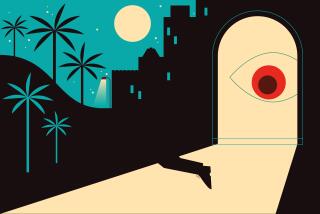A Haunting Sense of Loss in an Elusive City
- Share via
Paul LaFarge’s “The Artist of the Missing” is an appealing book to behold, and to hold. An original (trade) paperback novel, the author’s first, it fits comfortably into the reader’s hand. It is attractively designed. It features illustrations by Stephen Alcorn. Their winsome, urbane, old-fashioned graphic quality marries nicely with LaFarge’s narrative, which at its best is all these things, plus thoughtful, melancholy and slightly awed--awed by the infiniteness of city life, the mysteries of love, the majesty of loss.
Ambitious and dreamlike, “The Artist of the Missing” tells the story of Frank, a young man who arrives one day in an unnamed city with his childhood companion, James. Frank and James have lived together, on a farm in the (also-unnamed) country, since they were 5, when Frank’s parents went south to parts unknown, ostensibly on business. Only later in life does Frank realize that “going south” is a figure of speech and that his parents are in fact dead. For 15 years, Frank recognizes, he has been “victim to a story.”
In the city, Frank embarks on a journey that is, in one way or another, a refraction of this seminal early experience of loss. He and James move into a boardinghouse run by a Mrs. Bellaway that is favored by traveling judges. In exchange for his room, Frank works in Mrs. Bellaway’s laundry; eventually he takes up drawing, while James plays the guitar and teaches dance. James soon meets and falls in love with a girl, Rosalyn, and goes off with her; in continuing to search for the missing parts of his own life, Frank, meanwhile, sets off one day to look for a section of the city captured in the background of the one photograph he has of his parents.
The place eludes him, but during his quest he meets Prudence, a police photographer who has taken pictures of 3,682 corpses. Her photos make the dead speak (she captures clues in her images), and they inspire Frank to try to draw the dead himself. He is not successful. Frank believes that “there must be something more to life than its end.” He is more compelled by the living--Prudence in particular, whom he draws, then falls in love with, then loses, when she herself goes missing.
Missing the noun, as in people who have disappeared, and missing the verb, as in feeling the absence of someone, become the leitmotifs of Frank’s life and the novel alike. When Frank roams the city in search of Prudence, he learns that there is a whole world of people who have lost people, “the community of those who are looking.” “You’ll get used to . . . the missing,” one of them tells him in a nice play on words that, alas, never quite comes true, as it cannot, since one never gets fully used to the missing.
*
In time, Frank discovers that he has a talent for drawing portraits of people who have disappeared, based on descriptions by people who knew them. They are printed up on posters and turn Frank into “the great artist of the missing.” As LaFarge’s plot becomes increasingly baroque, they also land Frank in prison (for circumventing established police procedures), make him famous (when a gallery owner and curator “discover” his work), and send him on a journey through a kind of other- or underworld that ends when a giant wave comes to destroy and remake the city.
Allegories are not easy to sustain over 241 pages, and at about midpoint LaFarge’s novel begins to falter. The elements in the story that at first beguiled--Frank’s sad origins, his picaro-like adventures in this queer urban landscape, his tender romance with the elusive Prudence, his various losses and his encounters with curious cicerones--begin to feel arbitrary, too episodic, and insufficiently rooted in emotional or psychological reality. It is hard, in the end, for a reader to stay fully with a character whose interior life remains so spare and unvaried.
LaFarge is probably at his best when he conveys the magically layered quality of the city’s life and landscape: the cellars in iron buildings that fill each night with smoke and music; the railroad station where “time itself seems to have been held up by an unexpected delay somewhere farther down the line”; the complexity of its physical layout, which is known completely only by nine men, each 119 years old, because the city takes that long to learn. The city, then, is LaFarge’s ultimate protagonist: a place faceted, ever-changing and (like all cities everywhere) remaking itself all the time.
More to Read
Sign up for our Book Club newsletter
Get the latest news, events and more from the Los Angeles Times Book Club, and help us get L.A. reading and talking.
You may occasionally receive promotional content from the Los Angeles Times.









